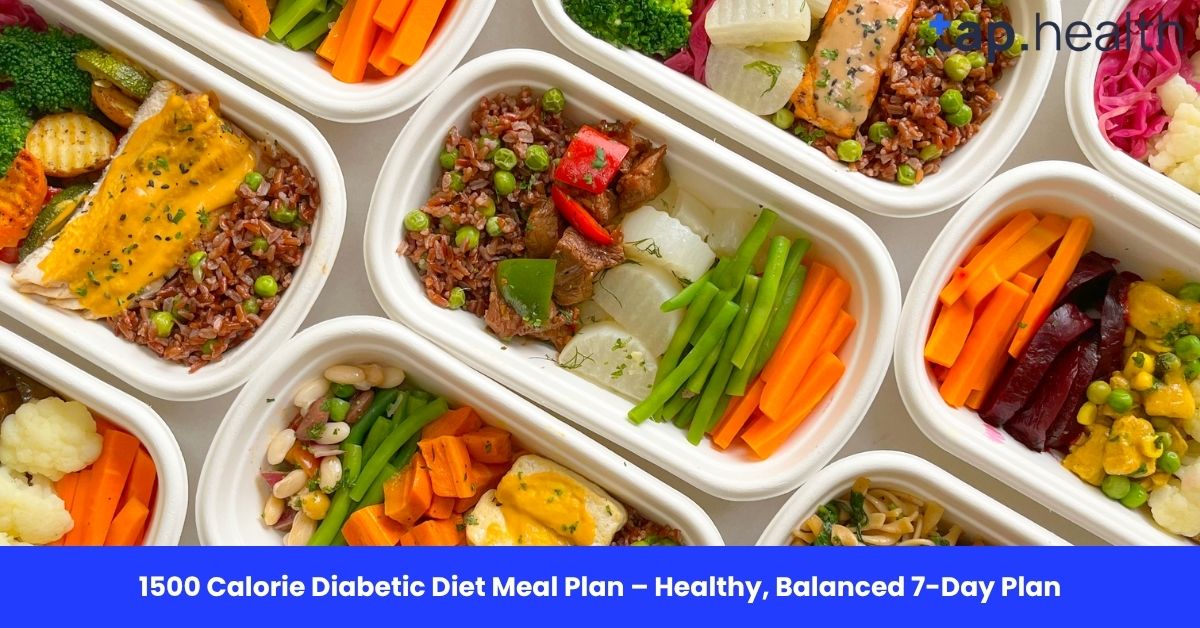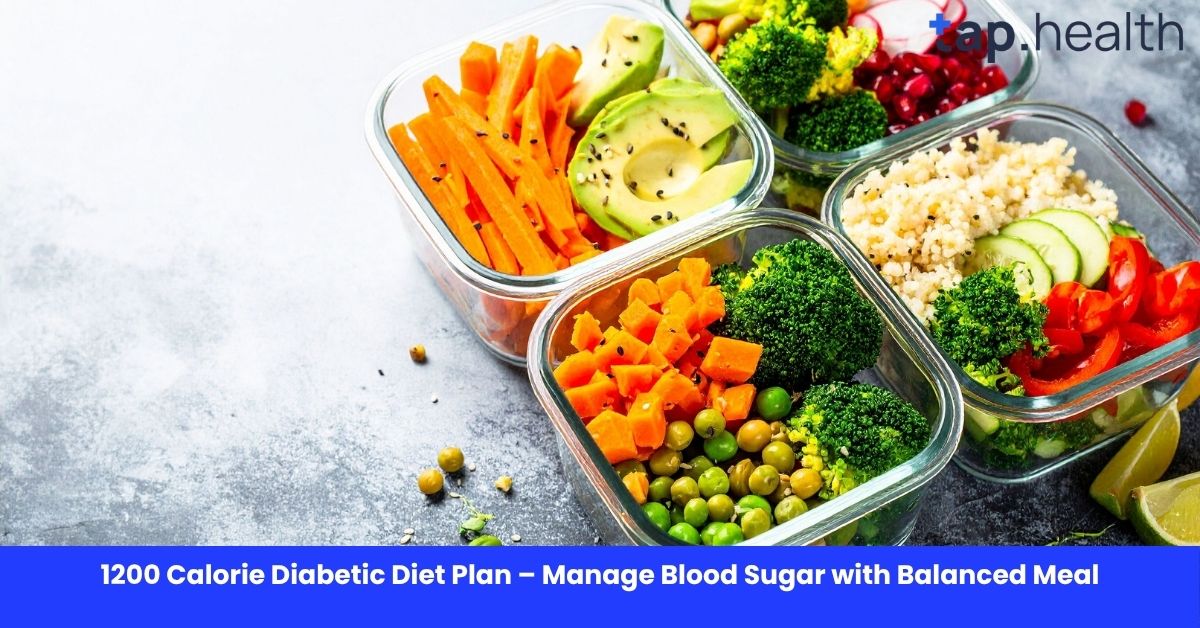Managing blood sugar levels is crucial for individuals with diabetes. A 1500 calorie diabetic diet meal plan can be a great way to regulate blood glucose while ensuring you get the nutrients your body needs. This plan is balanced and designed to help you maintain a healthy weight, keep your energy levels stable, and avoid blood sugar spikes.
In this article, we will break down the 1500 calorie diabetic meal plan, providing detailed meal suggestions, tips on food choices, and a breakdown of how this diet can help manage diabetes. We will also address frequently asked questions (FAQs) and explore the benefits and possible side effects of following this diet.
Why Choose a 1500 Calorie Diabetic Diet?
A 1500 calorie diet is often recommended for people with type 2 diabetes who need to control their weight, manage their blood sugar, and achieve overall better health. The 1500-calorie plan is neither too restrictive nor too lenient, making it an ideal choice for many individuals who want to balance their calorie intake without feeling deprived.
The key to a successful diabetic meal plan is to focus on foods that are low glycemic index (GI), high in fiber, rich in protein, and include healthy fats. These elements help maintain stable blood sugar levels and prevent rapid spikes and crashes.
Key Benefits of a 1500 Calorie Diabetic Diet
Before diving into the details of the meal plan, let’s take a look at the key benefits of a 1500 calorie diet for diabetics:
1. Improved Blood Sugar Control
By regulating calorie intake, this plan helps prevent extreme fluctuations in blood glucose. The focus on low-GI foods ensures that sugars are released gradually, reducing the risk of spikes.
2. Weight Management
A balanced 1500-calorie diet helps individuals manage their weight, which is crucial for improving insulin sensitivity. Losing weight can significantly help reduce the risk of complications from diabetes.
3. Stable Energy Levels
The inclusion of balanced meals rich in proteins and fiber helps you feel full longer and prevents sudden energy crashes.
4. Heart Health
This diet emphasizes foods that are heart-healthy, like lean proteins, healthy fats, and whole grains, which are important for individuals with diabetes to reduce the risk of cardiovascular disease.
How the 1500 Calorie Diabetic Meal Plan Works
The idea behind a 1500-calorie meal plan is to provide adequate nutrition while controlling the number of calories you consume. This plan includes a balance of carbohydrates, proteins, fats, and fiber. Let’s break down how each of these macronutrients plays a role:
1. Carbohydrates
Carbohydrates directly affect blood sugar levels. For diabetics, it is crucial to focus on complex carbohydrates and foods with a low glycemic index (GI), such as whole grains, vegetables, and legumes. These foods are absorbed slowly, helping to avoid sudden spikes in blood glucose.
2. Protein
Protein helps in muscle maintenance, supports immune function, and provides long-lasting energy. Lean proteins like chicken, fish, tofu, and legumes are excellent choices.
3. Healthy Fats
Healthy fats, including avocados, olive oil, and nuts, play a crucial role in improving heart health and helping with satiety. These fats also provide a source of energy that does not cause blood sugar spikes.
4. Fiber
Fiber is key to digestive health and plays a significant role in blood sugar control. High-fiber foods like vegetables, fruits, legumes, and whole grains should be included in every meal.
7-Day 1500 Calorie Diabetic Meal Plan (Indian Style)
Here’s a 7-day meal plan for 1500 calories per day that incorporates Indian foods, which are both delicious and diabetes-friendly. The meals are designed to be easy to prepare, nutrient-dense, and help regulate blood sugar levels.
Day 1
Breakfast:
- 1 small bowl of vegetable upma made with semolina, vegetables, and minimal oil
- 1 small orange
Lunch:
- 1 small bowl of mixed vegetable curry (spinach, cauliflower, and bell peppers) with minimal oil
- 1 small bowl of brown rice
- 1 small bowl of cucumber raita (low-fat yogurt)
Dinner:
- 2 small grilled fish fillets (salmon or mackerel)
- 1 small bowl of boiled quinoa
- 1 small bowl of sautéed green banana with minimal oil
Snack:
- 1 small apple
- 1/4 cup of roasted unsalted peanuts
Day 2
Breakfast:
- 2-egg omelette with spinach, tomatoes, and onions cooked in minimal oil
- 1 small bowl of mung bean sprout salad with onions and lemon juice
Lunch:
- 1 small bowl of vegetable curry (okra, bottle gourd, and eggplant) with minimal oil
- 1 small whole wheat roti
- 1 small bowl of cucumber raita (low-fat yogurt)
Dinner:
- 1 small grilled chicken breast marinated in Indian spices
- 1 small bowl of mixed vegetable stir-fry (cabbage, carrots, and beans) with minimal oil
- 1 small bowl of brown rice
Snack:
- 1 small apple
- 1/4 cup of roasted unsalted almonds
Day 3
Breakfast:
- 1 small bowl of vegetable poha (beaten rice flakes) with peanuts and minimal oil
- 1 small orange
Lunch:
- 1 small bowl of chicken curry (lean chicken pieces, tomatoes, and minimal oil)
- 1 small bowl of brown rice
- 1 small bowl of cucumber raita (low-fat yogurt)
Dinner:
- 1 small grilled fish fillet (tilapia or basa) with Indian spices
- 1 small bowl of mixed vegetable stir-fry (beans, carrots, and bottle gourd) with minimal oil
- 1 small bowl of boiled quinoa
Snack:
- 1 small bowl of roasted chickpeas
- 1 small apple
Day 4
Breakfast:
- 2 small idlis (steamed rice and lentil cakes) with coconut chutney and sambar
- 1 small bowl of low-fat plain yogurt
Lunch:
- 1 small bowl of spinach dal (lentil soup with spinach) with brown rice
- 1 small bowl of mixed vegetable stir-fry (beans, carrots, and cabbage) with minimal oil
Dinner:
- 1 small bowl of vegetable stew (coconut milk, mixed vegetables, and Indian spices) with brown rice
- 1 small bowl of cucumber raita (low-fat yogurt)
Snack:
- 1 small apple
- 1/4 cup of roasted unsalted peanuts
Day 5
Breakfast:
- 2 small whole wheat parathas stuffed with lightly spiced mashed paneer and spinach
- 1 small bowl of low-fat plain yogurt
Lunch:
- 1 small bowl of mixed vegetable curry (okra, bottle gourd, and eggplant) with minimal oil
- 1 small bowl of brown rice
- 1 small bowl of cucumber raita (low-fat yogurt)
Dinner:
- 1 small bowl of tandoori chicken (grilled chicken marinated with Indian spices and yogurt)
- 1 small bowl of mixed vegetable stir-fry (bell peppers, beans, and carrots) with minimal oil
- 1 small bowl of boiled quinoa
Snack:
- 1 small apple
- 1/4 cup of roasted unsalted almonds
Day 6
Breakfast:
- 1 small bowl of vegetable dalia (cracked wheat porridge) with lentils, vegetables, and minimal oil
- 1 small cucumber
Lunch:
- 1 small bowl of mixed vegetable curry (spinach, cauliflower, and bell peppers) with minimal oil
- 1 small bowl of brown rice
- 1 small bowl of cucumber salad with yogurt dressing (low-fat yogurt)
Dinner:
- 2 small grilled fish fillets (salmon or mackerel)
- 1 small bowl of sautéed green banana with minimal oil
- 1 small bowl of boiled quinoa
Snack:
- 1 small orange
- 1/4 cup of roasted unsalted peanuts
Day 7
Breakfast:
- 1 small bowl of vegetable upma made with semolina, vegetables, and minimal oil
- 1 small orange
Lunch:
- 1 small bowl of paneer tikka (grilled cottage cheese cubes marinated with Indian spices)
- 1 small bowl of mixed vegetable curry (cauliflower, carrots, and peas) with minimal oil
- 1 small bowl of whole wheat roti
Dinner:
- 1 small bowl of lentil soup (with vegetables and minimal oil)
- 1 small bowl of mixed vegetable salad (cucumber, carrots, tomatoes, and lemon juice)
Snack:
- 1 small bowl of low-fat yogurt
- 1 small bowl of mixed fruit salad (made with seasonal fruits)
FAQs About the 1500 Calorie Diabetic Diet
How much sugar is in a 1500-calorie diet?
The sugar content in a 1500-calorie diet depends on the food choices you make. Focus on whole, unprocessed foods and limit added sugars. Foods like fruit, vegetables, and whole grains have natural sugars that are slowly absorbed, while avoiding sugary drinks and snacks.
Is chapati okay for diabetics?
Yes, chapati (whole wheat roti) is a good choice for diabetics, especially if it’s made with whole wheat flour. It has a low glycemic index compared to white rice and provides essential fiber that helps control blood sugar levels.
What is an example of a 1500 calorie diet plan?
An example of a 1500-calorie diabetic meal plan includes balanced meals with a focus on lean protein, complex carbs, and healthy fats. A sample day could include:
- Breakfast: 2 egg omelette with vegetables
- Lunch: Grilled chicken with brown rice and a mixed vegetable curry
- Dinner: Fish fillets with quinoa and sautéed vegetables
- Snacks: Roasted peanuts, fruits, or low-fat yogurt
How many eggs are 1500 calories?
The number of eggs that make up 1500 calories depends on their size. One large egg contains about 70 calories, so you would need approximately 21-22 eggs to reach 1500 calories, though it’s best to incorporate a variety of foods for a balanced diet.
Key Takeaways
- A 1500-calorie diabetic diet helps manage blood sugar levels while promoting weight loss and overall health.
- Focus on low glycemic foods, lean proteins, and healthy fats to maintain stable energy levels and control blood glucose.
- This 7-day meal plan is structured to provide balanced meals, including familiar Indian foods that are both diabetes-friendly and enjoyable.
- Consult a healthcare provider before starting any restrictive diet to ensure it meets your personal needs.


